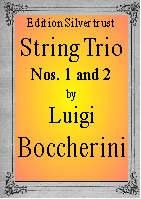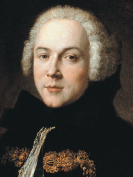Presents
Luigi Boccherini
|
String Trio No.1 |
 |
 |
String Trio No.2 |
String Trios for Violin, Viola & Cello
No.1 in F Major & No.2 in c minor, G.95 & 96
Luigi Boccherini (1743-1805) was born in the town of Lucca in northern Italy. He studied cello and became a virtuoso. But it was at a time that such players could not yet make a living from touring, so Boccherini found jobs in various orchestras in Vienna and Italy. Boccherini eventually moved to Paris where he hoped to establish himself as an independent soloist and composer but could not and was forced to take employment with the Spanish royal family for the rest of his life.
Boccherini was a very prolific composer writing for virtually every genre which then existed. As a string player, he knew how to make string instruments sound their best. His chamber music shows him as one of the great pioneers of instrumental technique, especially for the cello. He and Haydn were regarded as the two finest composers of third quarter of the 18th century. While today the string quartet is the “King” of chamber music ensembles, during the last half of the 18th century, the string trio was the most popular chamber ensemble and virtually all of the active composers lavished their talents on them.Haydn, Pleyel, Giardini and Mozart, to name but a few, all spent time and effort writing trios.
Boccherini wrote over 70 string trios, however, all but a dozen or so are for 2 violins and cello, rather than what became the standard combination of violin, viola and cello. Trio Nos. 1 & 2 are part of a set of six which were published together as his Op.14 in 1772. He was then at the height of his powers. In these trios, the roles and importance of each instrument is constantly varied. While the viola is often the glue between the violin and the cello, at times, it becomes the the soloist. But in these trios, it is the cello that is given a leading role much of the time. The writing spans the entire range of its registers, hopping from deep in its bass to high in its treble clef and requires the extensive use of thumb position.
|
Notes to String Trio No.1 |
Notes to String Trio No.2 |
|
The first trio is three movements and ends with a Minuetto, a traditional ending before 1780, while the second trio has a fourth movement. The elegant, first movement of No.1 is marked Allegro, is in the pre-classical style of the Mannheim school, yet the writing is not in concertante style but rather of the later type in which employs much more complicated harmony in the other parts. Right from the start the cello is given opportunities which perhaps were meant to show off Boccherini's own skills. Here the writing is in concertante style. The second movement, Adagio assai, is a sad dirge in the classical style. The cello, in its tenor register, gives baleful but lovely melody. Higher and higher it soars, all the why crying out its gorgeous lament. Surely this is one of the finest movements from the classical trio literature. The finale, is a quintessential classical Minuetto. Stately but not too slow.
|
Trio No.2 is in four movements opening with an Allegro moderato. The minor makes itself felt immediately in the first theme. The music combines a stately elegance with pensive excitement. In this rather substantial movement, as nowhere else, the cello is given extended intricate passages high in tenor and treble clefs ans well as some of the Italian bel canto melody in the music. The second movement is a short Adagio, the cello is again given the lead in bring forth the beautiful melody. The Tempo di Minuetto the violin and viola weave a fine cloth which serves as a protechnical early classical minuet, but it is the lively trio which is particularly noteworthy and original. The firey finale, Prestissimo, brings this excellent work to and exiting close |
These trios are among the finest in the classical literature little gems which we believe professional and amateur trio groups will greatly enjoy.
Trio No.1 Parts: $19.95 / Trio No.2-Parts: $19.95
Special Offer: Both Trios: $29.95